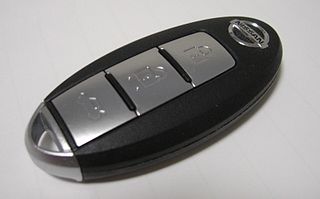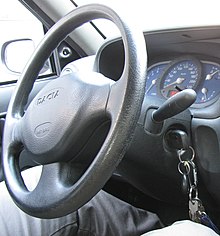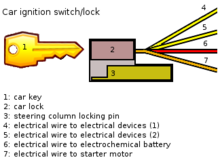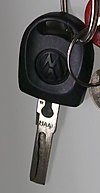
In telecommunications, a transponder is a device that, upon receiving a signal, emits a different signal in response. The term is a blend of transmitter and responder.

Motor vehicle theft is the criminal act of stealing or attempting to steal a motor vehicle. Nationwide in the United States in 2020, there were 810,400 vehicles reported stolen, up from 724,872 in 2019. Property losses due to motor vehicle theft in 2020 were estimated at $7.4 billion. There were 505,100 car thefts in the EU in 2019, a 43% decrease from 2008.

A lock is a mechanical or electronic fastening device that is released by a physical object, by supplying secret information, by a combination thereof, or it may only be able to be opened from one side, such as a door chain.

A car alarm is an electronic device installed in a vehicle in an attempt to discourage theft of the vehicle itself, its contents, or both. Car alarms work by emitting high-volume sound when the conditions necessary for triggering it are met. Such alarms may also cause the vehicle's headlights to flash, may notify the car's owner of the incident via a paging system, and may interrupt one or more electrical circuits necessary for the car to start. Although inexpensive to acquire and install, the effectiveness of such devices in deterring vehicle burglary or theft when their only effect is to emit sound appears to be negligible.
Hot-wiring is the process of bypassing a motor vehicle's ignition switch and thus starting it without the key. It is often utilized during a vehicle theft. However, a legitimate vehicle owner who has lost a vehicle key or starting a vehicle with inoperable ignition switch may also implement this process.

An automotive battery, or car battery, is a rechargeable battery that is used to start a motor vehicle. Its main purpose is to provide an electric current to the electric-powered starting motor, which in turn starts the chemically-powered internal combustion engine that actually propels the vehicle. Once the engine is running, power for the car's electrical systems is still supplied by the battery, with the alternator charging the battery as demands increase or decrease.

A smart key is an electronic access and authorization system that is available either as standard equipment or an option in several car designs. It was developed by Siemens in 1995 and introduced by Mercedes-Benz under the name "Keyless-Go" in 1998 on the W220 S-Class, after the design patent was filed by Daimler-Benz on May 17, 1997.
Anti-theft systems protect valuables such as vehicles and personal property like wallets, phones, and jewelry. They are also used in retail settings to protect merchandise in the form of security tags and labels. Anti-theft systems include devices such as locks and keys, RFID tags, and GPS locators.

A remote keyless system (RKS), also known as remote keyless entry (RKE) or remote central locking, is an electronic lock that controls access to a building or vehicle by using an electronic remote control (activated by a handheld device or automatically by proximity). RKS largely and quickly superseded keyless entry, a budding technology that restrictively bound locking and locking functions to vehicle-mounted keypads.

A tell-tale, sometimes called an idiot light or warning light, is an indicator of malfunction or operation of a system, indicated by a binary (on/off) illuminated light, symbol or text legend.

An immobiliser or immobilizer is an electronic security device fitted to a motor vehicle that prevents the engine from being started unless the correct key is present. This prevents the vehicle from being "hot wired" after entry has been achieved and thus reduces motor vehicle theft. Research shows that the uniform application of immobilisers reduced the rate of car theft by 40%.
The following outline is provided as an overview of and topical guide to automobiles:
An anti-hijack system is an electronic system fitted to motor vehicles to deter criminals from hijacking them. Although these types of systems are becoming more common on newer cars, they have not caused a decrease in insurance premiums as they are not as widely known as other more common anti-theft systems such as alarms or steering locks. It can also be a part of an alarm or immobiliser system. An approved anti-hijacking system will achieve a safe, quick shutdown of the vehicle it is attached to. There are also mechanical anti-hijack devices.
SecuriLock, also known as Passive Anti-Theft System (PATS), is Ford Motor Company's immobilizer technology. In 1996 the technology started showing up on select models of Ford, Lincoln, and Mercury vehicles. The keys have a radio frequency transponder embedded in the plastic head with a unique electronic identification code.
The Motor Vehicle Owners' Right to Repair Act, sometimes also referred to as Right to Repair, is a name for several related proposed bills in the United States Congress and several state legislatures which would require automobile manufacturers to provide the same information to independent repair shops as they do for dealer shops.
Automotive electronics are electronic systems used in vehicles, including engine management, ignition, radio, carputers, telematics, in-car entertainment systems, and others. Ignition, engine and transmission electronics are also found in trucks, motorcycles, off-road vehicles, and other internal combustion powered machinery such as forklifts, tractors and excavators. Related elements for control of relevant electrical systems are also found on hybrid vehicles and electric cars.
A remote starter is a radio controlled device, which is installed in a vehicle by the factory or an aftermarket installer to preheat or cool the vehicle before the owner gets into it. Once activated, by pushing a button on a special key chain remote, it starts the vehicle automatically for a predetermined time. Different models have keyless entry as well. Most newer vehicles need some kind of bypass module to bypass the factory anti-theft system, so the vehicle can be started without the ignition key in the ignition, this is bypassed only to start the vehicle, which after it is running returns to its original state. For cars with manual transmission additional safety features may need to be added to prevent the car from starting while it's parked in gear. Having a remote starter installed in a vehicle will usually not void the factory warranty when installed properly.

An alternator is a type of electric generator used in modern automobiles to charge the battery and to power the electrical system when its engine is running.
Automotive hacking is the exploitation of vulnerabilities within the software, hardware, and communication systems of automobiles.












